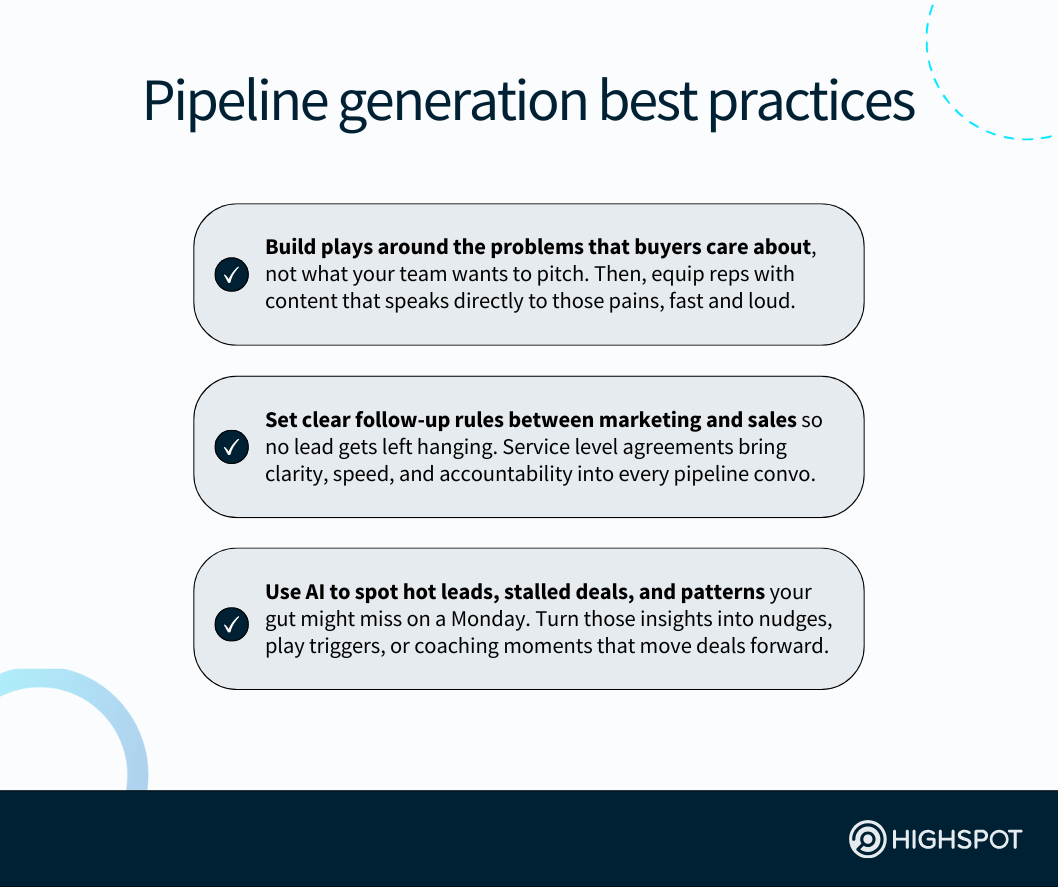Key Takeaways
- Pipeline generation is about precision, coordination, and action across your go-to-market (GTM) teams. Equip reps with buyer-focused content, AI insights, and timely follow-ups to drive real pipeline momentum.
- The best pipeline generation strategies align teams around SLAs, high-yield personas, and sales plays that meet buyers where they are. When executed well, they drive higher conversions and lead to savvier sales forecasting and better revenue outcomes for your business.
- To improve your pipeline generation efforts—and, in turn, your sales performance—integrate adaptive training, smart lead scoring, and AI-powered opportunity evaluation into daily workflows. Every GTM motion should be purposeful, repeatable, and tied to business impact.
You and other GTM leaders have built a sales pipeline generation machine that runs pretty well (most days, at least). You’ve got the right plays, the right platforms, the right people.
But if you’re here, you’re not looking for more of the same. You’re looking for that edge.
The smarter way to fuel go-to-market performance.
The next-best step to take your pipeline generation efforts to new heights.
Because modern pipeline generation isn’t a solo act. It’s a collective effort by your sales and marketing teams. It only works with a mutually developed sales and marketing plan.
And don’t forget sales enablement’s sizeable role in making sure every touchpoint—every training, every pitch—is sharp, relevant, and revenue-ready.
This isn’t your “How to build a funnel 101” kind of post. You already know how to execute and convert paying customers at a strong clip.
You’re here to ensure everyone across your GTM teams is prepared to play a pivotal role in building and engaging leads in your pipeline—with speed, precision, and purpose.
So, let’s break down the key tactics and approaches that separate good GTM teams from great ones and help you enhance your lead generation, better engage qualified leads, identify patterns in your sales outreach, and implement a more data-driven approach that uses the right metrics to convert pipeline at scale.

What is pipeline generation?
Sales pipeline generation is the process of identifying and attracting potential customers to move them into the sales funnel and progressively advance them through buyer engagement. It’s primarily driven by marketing and sales teams that work together on targeted lead generation, scoring, and nurturing activities.
Effective pipeline generation focuses on engaging your target audience through custom-tailored inbound campaigns and research-backed outbound motions using relevant content and coordinated plays. It’s about adding a high quantity and quality of qualified prospects into your CRM system that align with your ideal customer profile.
7 traits of a highly effective pipeline generation strategy
“Often, an underperforming pipeline is the result of an inconsistent go-to-market motion that fails to standardise execution and operationalise performance,” according to Highspot’s A Fast-flowing Sales Pipeline guide for GTM leaders.
But as the guide explained, with the right sales enablement strategy, your go-to-market teams “are empowered to identify and fortify the cracks in your current pipeline and, from there, build stronger, cleaner pipeline down the line.”
In short, there are seven key attributes of sales pipeline generation strategies that can ensure your enablement, marketing, and sales teams work in tandem.
Specifically, ones that can help you address significant challenges with your sales process, ensure you identify and engage only high-quality leads, and—at the end of the day—gain a competitive advantage in your industry and vertical.
1. Aligned sales, enablement, revenue, and marketing teams
When all your go-to-market teams actually talk to and collaborate closely with each other, magic happens. Alignment lets you strike the right balance between who drives what, when, and how, all without tripping over each other’s territory.
That harmony within your GTM operations helps generate interest across the funnel and guides leads with precision throughout the B2B buyer’s journey.
It’s how you ensure consistent messaging is delivered to buyers while and tailor each touchpoint to what resonates in today’s modern buying process. Tight sales and marketing alignment is the fastest route to winning more with less wasted motion.
2. Agreed-upon definition of the ideal customer profile
When everyone’s chasing different buyers, your go-to-market strategy starts to look like a game of telephone gone wrong. That’s why a shared ideal customer profile (ICP) defined by every key GTM stakeholder ensures your sales team and marketers are targeting the same people with the same priorities.
This keeps your personalised emails and messaging to qualified prospects laser-focused on the pain points and needs of buyers who are most likely to convert.
Equally as important, it ensures you don’t cast too wide a net and add unqualified leads to your sales pipeline (read: those who will never buy from you).
3. Proactive lead generation by both marketing and sales
Lead generation is a full-field press from both marketing and sales at the most successful B2B companies today, not a siloed activity by just one team.
Your sales team should be doing more than waiting for form fills on your website to trickle in.
High-performing reps use targeted outbound techniques, such as proactive social selling on LinkedIn, and leverage value-packed, personalised content to engage prospects who closely match their ICP before they’ve even raised a hand.
Meanwhile, your marketing team is charged with fueling the sales funnel with integrated campaigns designed to spark curiosity and generate a high volume of leads—one of the most tried-and-true B2B pipeline generation strategies today.
When both your sales and marketing teams are actively on the hunt for prospects in sync, your pipeline goes from passive to packed, with real opportunities that have a high chance of turning into future sales in the weeks and months ahead.
4. Concerted lead-scoring approach to grade prospects
Not all leads are created equal, and treating them like they are is a fast path to sales pipeline chaos. An intelligent scoring model helps your GTM teams gauge leads’ interest and buying readiness with your wealth of sales analytics, not just gut instinct.
The most impactful (and profitable) scoring models consider lead quality, engagement, fit, budget, timing, and other relevant buying signals to ensure marketing-qualified leads handed off to your sales team are actually worth your reps’ time.
Only with this approach to evaluating buyers—and a unified sales tech stack built around your CRM system and GTM enablement platform—can your sellers move faster, show up smarter, win more, and get out of the tire-kicker trap for good.
5. Coordinated lead-nurturing efforts by all GTM teams
Lead nurturing is a team sport, not a solo sprint. It requires marketing, sales, and enablement to work off the same exact playbook, not in silos.
Your sales content should evolve with each stage of the journey to guide leads through the sales cycle with confidence. It’s all about delivering the right message, at the right moment, through the right channel, to the right persona.
That orchestration helps build trust, shorten timelines, and keep your prospects engaged from first touch to purchase decisions. When you coordinate your nurture flows across GTM functions, you’re effectively ‘pre-closing’ deals.
6. Improved sales forecasting to anticipate deal conversions
With an effective pipeline strategy, you don’t just react to buyer behaviour. You also predict actions, and—with the right tools—do so with precision and confidence.
Modern B2B sales forecasting blends human expertise with AI-powered insights. This combination helps you anticipate deal movement and revenue impact.
Integrating your CRM system and GTM enablement platform makes it easy to anticipate deal risk, prospect needs, and—most importantly—projected revenue in the coming months.
Forecasting is how you uncover which deals are real, which aren’t worth your reps’ time, and which account stakeholders just need a gentle nudge to close.
7. Collaborative customer relationship management efforts
Customer relationship management is a mindset, muscle, and measurable part of pipeline excellence. When executed well by your sales and marketing teams, it ties lead management, buyer engagement, enablement-built collateral and messaging, and real-time rep activity into a single source of go-to-market truth.
That transparency with your CRM strategy fuels better coaching, more aligned plays, and smarter hand-offs across marketing, sales, and customer success teams.
| Pipeline generation FAQ | Answer |
| How can I align my teams to consistently deliver strong pipeline generation outcomes? | Start by defining shared goals, roles, and expectations across marketing, sales, and enablement. Use a data-driven approach to continuously monitor and adjust pipeline generation activities based on real-time performance. When everyone is accountable for outcomes, it’s easier to collaborate, course-correct, and drive predictable business outcomes. |
| What’s the best way to generate high-quality leads that actually convert into sales? | Create targeted campaigns around your ICP and align messaging to buyer needs and triggers. Build in lead-qualification criteria that factor in buyer behaviour and readiness signals to improve conversion rates. This ensures your teams spend more time engaging sales opportunities with a higher likelihood to close. |
| How can I track sales pipeline health in real-time and take faster action when needed? | Use go-to-market tools that surface insights across every stage—from outreach to closed-won—so you know what’s working. Highspot, for example, helps you understand sales pipeline momentum, identify deal risks, and take action with embedded AI agents. This lets you coach reps, re-activate deals, or pivot strategies quickly to protect your revenue targets and goals. |
| Why aren’t our sales pipeline numbers leading to better win rates or more revenue? | More pipeline doesn’t always equal better outcomes, if reps aren’t enabled to convert. Look at conversion rates by deal stage to see where sellers get stuck or lose momentum. Use those insights to prioritise BDR training, improve content, and adjust your sales process based on what wins. |
| How do I know if we’re focusing on the right pipeline generation activities and tactics? | Start by identifying which programmes and plays produce the highest conversion rates and shortest time to opportunity. Map those go-to-market activities to your top-performing sales reps and campaigns to build repeatable playbooks across the team. Then, test and refine your approach based on results to ensure your efforts directly impact the right business outcomes. |
| What key metrics should we track to gauge sales pipeline generation effectiveness? | Beyond total pipeline created, measure conversion rates by stage, time to opportunity, and rep follow-up velocity. Track which plays and assets influence the most deals and link content use to rep outcomes. Use this data to double down on what drives results and cut what isn’t moving the needle. |
| Which marketing and sales tools do we need for effective pipeline generation today? | Get tools that unify engagement, content, training, and analytics so your enablement, sales, and marketing teams operate with precision. Platforms like Highspot give sellers instant access to relevant assets and data-driven guidance at every moment. When tech enables collaboration and speed, your GTM teams can move fast and generate pipeline that converts. |
| How can we connect pipeline generation to our sales process and revenue outcomes? | Integrate your sales pipeline generation strategy into go-to-market enablement programmes so reps know how to follow up effectively. Build campaigns and plays that guide reps from first touch to qualified opportunity within your sales process. This ensures pipeline creation isn’t just a volume play. Instead, it’s tied to real sales opportunities and closed business. |
How to build a pipeline generation strategy that improves GTM performance
Aligning sales and marketing is just the starting point of your pipeline generation strategy.
To ensure both these go-to-market teams work well with one another to get more qualified leads in the door, connect with members of your target audience in a timely and personalised fashion, and—ultimately—close more deals, you must also:
Create SLAs to cement sales and marketing alignment
The most successful pipeline generation strategies involve lockstep coordination between sales and marketing. We don’t just mean having shared sales dashboards but also shared commitments and expectations of one another.
Establishing a service level agreement between both GTM functions ensures leads are sent, accepted, and followed up with accountability baked into every step.
Your SLA should define timelines for handoffs, qualification criteria, follow-up cadence, and clear expectations on what good looks like for marketing-qualified leads.
For instance, a 24-hour follow-up window for MQLs combined with lead-rejection reasons tracked in your CRM system helps surface gaps faster.
An effective service level agreement is ultimately a coordinated, strategic contract that drives precision, focus, and forward motion across these GTM teams.
Account for company’s your revenue targets and goals
Your pipeline generation plan is only as strong as its connection to strategic revenue targets.
Tie your lead-generation and lead-nurturing efforts to North Star business goals like ARR growth, expansion revenue, and territory coverage. This ensures you’re filling the funnel with intent—not just activity—and prioritising the right mix of deals to support long-term health.
Without that line of sight, pipeline becomes performance theater: a flood of deals with no path to quota for your sales reps or board-level outcomes your C-suite expects of GTM.
Every GTM motion implemented should ladder up to the big-picture, strategic initiatives leadership actually cares about. What’s more, revenue operations must be able to report on pipeline generation efforts and results with confidence.
Focus GTM programmes around your high-yield personas
Don’t dilute your pipeline generation strategy by having reps chase every lead in the wild.
Ensure they focus on the buyer personas that tend to yield high annual contract values, something you can discover by analysing historical deal data.
This sharpens every GTM programme and campaign, aligning your marketing, enablement, and outbound motions strictly to the accounts that move the needle.
It also ensures your reps work fewer, better leads, saving them time, boosting sales team morale, and improving win rates and customer experience in parallel.
For example, your best-performing vertical might be mid-market manufacturing CIOs buying for global rollout. So, build targeted plays that speak just to them.
Buyer persona and ICP specificity turns vague pipeline into real pipeline, grounded in signals that indicate urgency, budget, and decision-making authority.
Operationalise your sales plays for key buyer scenarios
Sales plays don’t work just sitting in a folder. They only succeed when embedded into your BDRs’ sales prospecting efforts. With Highspot, you can build scenario-specific plays with the right content, talk tracks, and training aligned to each motion.
Your enablement team can surface plays to reps at the right time using Highspot Nexus™, our AI and analytics engine, and rely on the platform to interpret deal context and recommend next-best actions to your sellers based on data tied to the buyers’ journey.
For instance, when selling into procurement-led IT deals, your sales reps see exactly what’s worked before, like which content and messaging resonated with leads and what answers to prospects’ questions moved deals along and best handled their objections.
And all without having to spend several minutes (or—gasp—hours) searching.
Instead, data-backed, actionable insights are served up to them instantly.
Highspot Agents can even automate play distribution based on deal stage, so each sales rep enters key conversations with total confidence and zero guesswork.
Equip your sellers with relevant, buyer-focused content
Generic sales pitch decks, dated sell sheets, and stale case studies won’t cut it with your pipeline generation approach. Sellers need enablement collateral tailored to prospects’ pain points, industry, business model, and buyer maturity level.
That means investing in assets that speak to key decision-makers at target accounts and fits within your strategic positioning. Reps should be able to find it fast, personalise it easily, and deliver it in a way that drives action across every stakeholder.
Your enablement team must continuously refine what works based on BDR feedback, lead engagement data, and how content performs across sales funnel stages.
Launch multi-threaded outbound and inbound motions
Multi-threading accelerates trust with stakeholders at accounts reps prospect by building credibility across lines of business, not just with one champion.
Account executives can enter the equation in late-stage deals.
Notably, they can leverage digital sales rooms, like those Highspot customers use in deal discussions, along with custom decks and executive-level calls to action to convince skeptics, blockers, and budget holders alike to sign on the dotted line.
Having AEs use thought leadership content can get deals across the finish line.
“Thought leadership that spurs business leaders to rethink their challenges is a powerful tool for stimulating demand for your business’s products and services,” per Edelman and LinkedIn’s 2024 B2B Thought Leadership Impact Report.
Measure what’s working, and optimise efforts in real-time
Analytics shouldn’t be backward-looking. It should guide every next move you make across GTM activities. Blend your prospect and customer data with sales intelligence to identify what’s generating pipeline and what’s dragging it down.
Look at sales velocity and deal conversion by campaign and initiative, asset usage by stage, and rep response time to qualified leads so you can surface where friction is killing flow.
Also, be sure to regularly analyse shown, shared, and spoken buyer signals, and use that account-centric insight to dial up actions that move deals forward.
Reinforce rep skills and messaging with adaptive training
One-time, broad sales trainings fade fast. Learning must live inside your sales team’s workflows, with repetition that reinforces relevance and sharpens execution.
With Highspot, you can create custom learning paths aligned to critical plays, personas, and segments so each rep gets the education and insights they need, when they need it.
Nexus identifies skill gaps and the ideal learning speed and paths for each seller, enabling your sales managers to coach with precision, not assumptions.
Let’s say a particular rep underperforms in CFO-facing deals. Highspot can flag this issue and assign a quick-hit training or AI sales role play to build BDRs’ muscle.
Your go-to-market team’s sales coaching and training should evolve with performance, integrating seamlessly into every tool and touchpoint reps use daily.
Use AI sales tools to better evaluate active opportunities
Today’s B2B deals don’t follow a linear path. They’re messy. If your sales professionals are navigating them blind, pipeline-generation stalls become the norm.
That makes it critical to onboard the best AI sales tools: so you and other GTM leaders can lean on AI-powered insights that allow you to better read the room, assess deal urgency, and prioritise outreach with surgical accuracy and great timing.
Highspot’s Deal Agent, for example, evaluates the aforementioned buying signals and uses that data to guide your reps to the right actions that accelerate revenue.
Our AI sales agents don’t just provide recaps or call scores. They offer a real-time lens into buyer intent, risk patterns, and revenue probability so you can scale GTM growth.
Convert your sales pipeline smarter and faster with AI-powered enablement
In modern B2B sales, speed isn’t a luxury. It’s the playing field, and laggards don’t last long.
To shorten the sales cycle and boost your conversion rate, your GTM organisation must run on shared goals, connected systems, and dynamic enablement.
Simply put, the smartest go-to-market teams don’t wait for hindsight.
Rather, they identify areas of friction in real-time and course-correct before deals go cold.
Leveraging an AI-powered sales enablement platform means turning AI-powered insights into winning actions at scale, across reps, plays, and buyer stages.
The sooner you connect with the right audience, the sooner you stop guessing and start accelerating toward quota with purpose and predictability.
Investing in leading GTM tech is the secret to long-term, sustainable, scalable revenue growth—and the advantage your competitors hope you ignore.




